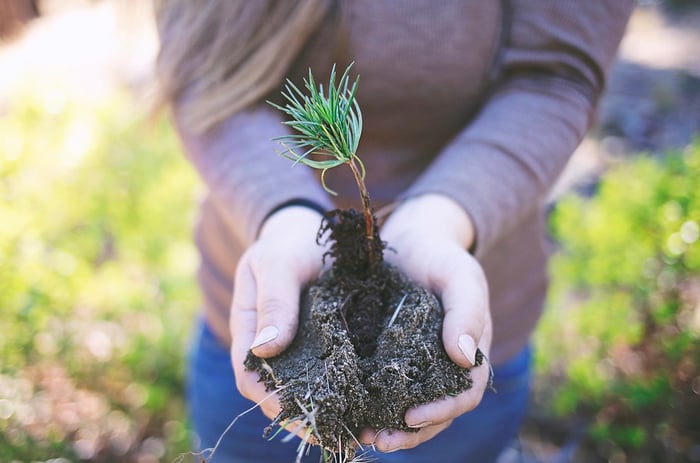 Photo: One Tree Planted
Photo: One Tree Planted
15.3 billion. That’s how many trees are chopped down every year, according to a 2020 study by British weekly scientific journal Nature. If we received $1 for every tree felled, that would be enough to buy 30 million iPads.
Those numbers are alarming and the US-based non-profit One Tree Planted is striving to undo the damage through global reforestation initiatives. As one of our Giving Program partners, abillion members can donate the amount they’ve earned from posting reviews – a dollar donated will plant one tree.
“We see deforestation as one of the great challenges facing our planet, and are dedicated to making a positive impact through reforestation initiatives across the globe.” - Ashley Lamontagne, Forest Campaign Manager at One Tree Planted.
The organization started out by repopulating longleaf pine trees in Texas in 2014—once the dominant tree species in the southeastern US, covering some 90 million acres. Over the last 400 years, this species' abundance has decreased due to non-sustainable timber harvest, clearing of land for agriculture and development, and fire suppression.
Today, the organization has planted over 40,000,000 trees in 43 countries.
We caught up with two of their team members Bill Toomey, Chief Tree Officer and Ashley Lamontagne, Forest Campaign Manager who shared about their organization’s impact and vision to reforest the world.
What is the mission of your company? What problems are you aiming to solve?
Ashley: One Tree Planted is a 501(c)(3) nonprofit on a mission to make it simple for anyone to help the environment by planting trees. We see deforestation as one of the great challenges facing our planet, and are dedicated to making a positive impact through reforestation initiatives across the globe.
 Photo: One Tree Planted
Photo: One Tree Planted
How do you plant trees with just $1?
Bill: Tree costs vary based on region, partner, and unique overall objective of a reforestation project. A simple average breakdown of how we get trees planted: site is prepared (10 cents), seedlings are grown (60 cents), trees are planted (15 cents) and trees are maintained and monitored (15 cents).
In some instances, we may combine resources with partners for co-funding to make a bigger impact at scale, but you can rest assured knowing that your donations will always go towards restoring healthy and thriving forests.
How do you ensure that they are maintained and not destroyed?
Bill: We remain closely engaged with our partners to monitor project progress and require reporting and photos at several stages over the life of the project, including an update on seedling production and site preparation, a report soon after planting is complete, and a follow-up report one year after planting. The key metrics we track include the total number of trees planted, species planted, survival rate, area under restoration, and the total number of permanent and seasonal jobs created.
Additional performance indicators may be reported according to the objectives of each project. To complement our partners’ existing protocols, One Tree Planted is currently in the process of implementing monitoring workflows that incorporate geospatial technologies such as high-resolution satellite and drone imagery. These tools will enable One Tree Planted to further validate the long-term success of projects.
Talk us through the initiatives that your organization is taking to address climate change?
Bill: One Tree Planted is in a unique position as an organization to directly address climate change because we are planting trees every day to restore critical forest habitat around the world. Planting trees and restoring healthy forests are referred to as natural climate solutions and are a critical part of effectively addressing our climate crisis. We also work with companies large and small to help them translate their sustainability and Net Zero commitments into reality.
 Photo: One Tree Planted
Photo: One Tree Planted
You have planted 40,000,000+ in 43 countries. Could you tell us the impact of it?
Bill and Ashley: Planting the tree is just the beginning of helping to grow healthy diverse forest ecosystems. In 2021, we planted 1,250 different species of trees across 166 projects around the world. The impact of trees planted have countless benefits, with the below touching on just a few:
- Sequestering carbon. To date, trees are the best-known carbon capture/storage technology. They're inexpensive to plant and grow, remarkably efficient at capturing and storing greenhouse gas emissions, and can live an extremely long time. Our carbon experts estimate that each tree absorbs 22lbs of carbon for the first 20 years of their lives.
- Restoration of ecosystems. Trees and forests support over 80 percent of the world's terrestrial biodiversity. Many of our projects are established to ensure both flora and fauna have healthy and sustainable habitats to call home.
- Supporting communities. Our projects help communities with jobs, training, and supporting families with improved income and access to food. Combining these outcomes not only helps those in need, but also ensures that trees planted are preserved for generations to come.
Some of the impact we were able to generate this past year include:
- Creating over 2,700 jobs
- Supporting over 35,000 farming families
- Employed over 5,000 women
What are the biggest challenges you face and how do you combat them?
Bill: There are several major challenges to planting trees and restoring forests at the pace and scale needed across the world. These include tree seed collection, growing quality trees seedlings in large quantities (hundreds of millions), building the organizational capacity of local planting partners, effective use of technology to measure impact, monitoring projects at scale, and ensuring commitments of funding over multiple years.
One Tree Planted is working in partnership with many groups and organizations to creatively and effectively address these challenges and are committed to overcoming them and growing the number of trees planted and increasing the amount of forests restored in the years to come.
Trees not just help in reforestation but also help animals. Can you tell us how your work in planting trees helps save animals? Do you have any case studies to share?
Ashley: It is estimated that 80 percent of the world’s terrestrial plants and animals live in forests, and trees help to provide them with food and shelter. While many suffer from habitat loss through deforestation, we are working to restore their homes through our reforestation initiatives. After the trees are in the ground, we start to see animals return to the area, and the forest's biodiversity begins to balance back out.
 Photo: One Tree Planted
Photo: One Tree Planted




